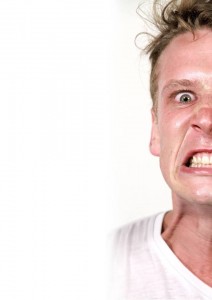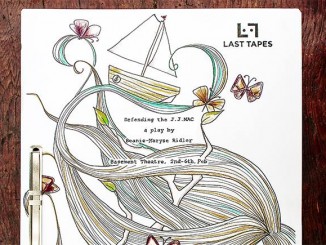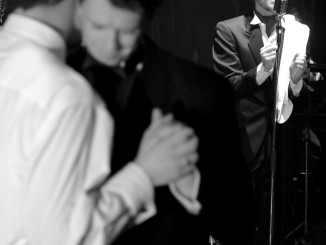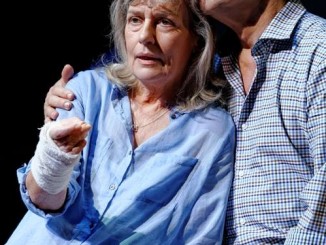
Perverse [by James Wenley]

For the past few weeks, Jordan Mooney has been posting a series of clips promoting a range of different vices. The crazy-eyed front man has whipped himself, walked naked in the wilderness, shoved his face in a toilet bowl, and lit his hair on fire.
Turns out these are child plays compared to some of the predilections in Vice, a sophisticated monologue show pairing seven writers with seven actors*, and assembled by Director Jordan Mooney (who also acts as crack fiend Peter Pipe) and dramaturg Benjamin Henson (whose work Confessions, the style and content remind me of). “You’re allowed one vice” Belle, played by Amanda Tito, states in the second to last monologue, and the writers take us into some dark and disturbing territory as each character’s vice is revealed.
Vice sees one of the most outrageous transformations of the upstairs Basement Studio, taking the Peter Brook approach and painting the stage end of the space stark white, instantly making this a defamiliar space indeed. But John Kaminski’s set design doesn’t stop there, plastering the audience’s walls and roof with glossy advertisements (might our vice be advertised here?). Rachel Marlow’s lighting gets the best out of this space, swapping shadows for a harsh white reflected back at us. Marlow’s design, and Sam Mence and Amber Molloy’s unsettlingly effective sound design, work together to emphasize beats within the monologues, and also positions some sort of exterior controlling threat, jolting the actors (and occasionally us). What I appreciated most from this design was the otherwise subtlety of the lighting states, slowly lighting and involving the audience in a way we are barely conscious of. It’s an environment we can never relax into.
If this isn’t confronting enough, having already been greeted by a black morph-suit usher in the shape of Chris Bryan at the door, the actors are already out in the stage in asylum-like arrangement. Showing a limited awareness of each other, and us, they engage in a series of repetitive behavior, seemingly stuck in their cycles. Pheobe Mason sits on kid tricycle playing with dolls. Sam Snedden, in kid’s shorts and with a bandaged hand, paces and inspects the fire exit door. Amanda Tito watches Sam, clicks, and outstretches her hand. Daniel Cresswell stands at the back, his gut hanging over his polka-dot pants, clutching an empty glass jar. Lauren Gibson winds her negligee and hides behind the wardrobe. Mooney, with a patchy shaved jaw and ripped garments, sits sniffing, twitching and flicking his tongue. Andrew Ford sits next to him facing the wall, rocking back and forth. The assumption this sets up is that these people are already abnormal. They are not us, with our secret hidden away vices. Their vices have overwhelmed and destroyed them.
As the show starts they speak in a babble, as if they can’t take being silent anymore. But it is Andrew Ford as Gareth (in a monologue written by Thomas Sainsbury) who goes first, mounting a defense of his porn addiction to “curb my desires”. He’s pathetic, and icky, creeping his hands down his track pants. More disturbingly, he’s actually one of the more “normal” characters we encounter.
Before Ford is quite finished, Daniel Cresswell’s Max bounds forward to begin his tale. In his monologue (written by Dan Musgrove) he reveals he himself has appeared in a porn video (“one man, one jar”, yikes!) and proceeds to revel in his shameless exhibitionism. Remaining very much in Ford’s space, Ford looks increasingly unhappy about the intrusion. It is these sorts of interactions between characters that give the show a sense of reckless theatricality, and Mooney continues to identify ways the characters can be involved (or repelled by) each other’s stories.
One by one, the characters get their chance to reveal all, the actors all getting their chance at their best crazy-eyes. In Happy Meal, by Benjamin Henson, a highly anxious Sam Snedden reveals some very particular mummy issues. Play, by Virginia Frankovich, sees a worryingly adorable Phoebe Mason engage with aspects of the adult world she does not yet fully understand. Melissa K. Martin’s A Cupboard has Lauren Gibson as a woman who loves too much (just what is inside that cupboard?). Belle, by Colin Garlick, has Amanda Tito relate a family trauma that takes a very dark turn, and Peter Pipe by Anthony James closes the show with Mooney as an apologetic crack addict.
The actors remain ‘in character’ for their bow, cautiously bending, surprised that we are clapping. They then go back to their places as if they will do it all again for the next group of audience members. So they’ve been assembled, a group of vice-freaks who perform for us. For what? Our amusement? A warning? A release? That they are so heightened means we cannot identify with them, so our own self-reflection is not invited. Crack and porn are the most mundane of the vices. Many are sexual in nature, and two involve parental abuse. To quote Peter Pipe, they are “pretty fucking twisted”, shedding light on some dark taboos.
Certainly there is plenty of dark humour to take the edge off things but this isn’t a funny show. Frankovich’s play gets the most laughter, with Mason giving a standout performance as the little girl obsessed with the bubble pool, creating sound effects with Barbie Dolls and performing her own version of Katy Perry’s Last Friday Night. Her story wraps up too easily when Mason decides to end her game, the monologue losing its nerve. Frankovich’s scenario explores what goes on in a child’s head. Gareth, Max, Belle and Peter are presented ‘as they are’, explaining themselves and their vice without much deeper psychological insight. Max as one of the shorter and most straight-forward does not make much of an impact. Belle is provoking because of the content, and Tito’s matter of fact delivery. Mooney’s Peter Pipe addict apologizes if he scares us, but we never feel any real danger, he’s safe rather than scary, and we don’t have as much to take away from his character other than as a portrait of the crack addict.
Benjamin Henson’s Happy Meal, performed by Sam Snedden, feels the most complete tale of depravity. The one character who doesn’t want to tell us about his vice, he takes us on tangents before revealing what he is so wound up about. And just as we think we’ve got a handle on him, and indeed feel sympathy for, he tells us there’s a “bit left out” and the story takes us to a new level of horror in an intense and painful revelation from Snedden.
While individual monologues may not be everyone’s vice, the show’s complete experience makes for a disconcerting airing of some of the more extreme perversions locked away in humanity’s cupboard.
*The show’s marketing promised “nine twisted tales” and Stephen Lovatt “like you have never seen him before”, but here we have seven, which makes for a good length. Can anyone confirm Stephen Lovatt’s whereabouts following Angels in America? Has anyone thought to check the cupboard?
Vice plays at The Basement Studio until 19 April. Details see The Basement.




Leave a Reply